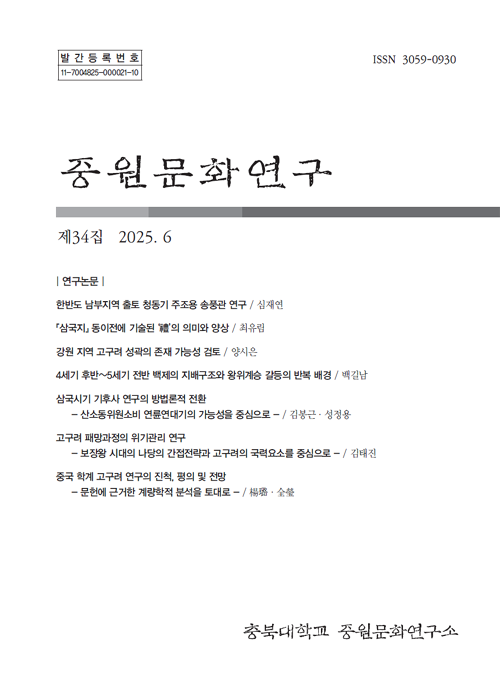- 영문명
- A Study on the Crisis Management of Goguryeo's Defeat Process : Focusing on the Indirect Strategy of Nadang and the Elements of Goguryeo's National Power during King Bojang
- 발행기관
- 충북대학교 중원문화연구소
- 저자명
- 김태진(Tai-jin Kim)
- 간행물 정보
- 『중원문화연구』제34집, 109~145쪽, 전체 37쪽
- 주제분류
- 인문학 > 역사학
- 파일형태
- 발행일자
- 2025.06.30
7,240원
구매일시로부터 72시간 이내에 다운로드 가능합니다.
이 학술논문 정보는 (주)교보문고와 각 발행기관 사이에 저작물 이용 계약이 체결된 것으로, 교보문고를 통해 제공되고 있습니다.

국문 초록
고구려는 668년 나당연합군의 공격으로 패망하였다. 고구려의 멸망원인에 대해서는 다양한 분석이 있으나 연개소문의 등장과 그 아들들의 내분으로 인한 것으로 보는 것이 역사학계의 보편적 관점이다. 반면 고구려의 패망과정을 위기관리 이론으로 접근한 연구는 확인하기가 제한된다. 따라서 이 논문은 고구려의 마지막 왕인 보장왕의 즉위로부터 고구려 멸망 후 보장왕에 의한 부흥운동에 이르는 시대를 위기관리 이론으로 분석하였고, 고구려를 패망시킨 나당은 간접전략으로 어떻게 고구려의 국력요소에 영향을 미쳤는지를 연구하였다. 보장왕의 26년 재위 시대와 고구려 멸망 후 13년간의 부흥운동 기간을 총체적 위기관리 이론의 4단계인 예방-대비-대응-복구로 구분하여 나당의 간접전략(Indirect strategy)이 각 단계별로 고구려의 국력요소(DIME)인 외교·정보·군사·경제에 어떤 영향을 주었는지를 확인하였다. 이를 통해 고구려 패망원인의 현상이 현 한반도 안보 상황에 주는 의미가 무엇인지를 제시하였다.
연구결과 고구려는 나당의 간접전략에 의한 내분이 원인이 되어 직접전략인 전쟁에 대비하지 못함으로 멸망하게 되었다. 보장왕 재위 시대의 대부분을 차지한 연개소문이 막리지로 있던 기간은 당나라와 동북아 패권을 다투는 전쟁을 진행하였다. 연개소문 사후 장남 남생이 막리지로 있던 기간은 내부분열로 아들들 간의 다툼이 진행되어 나당의 공격에 대한 대비를 하지 못하였다. 차남 남건이 막리지로 있던 기간에 나당과 전쟁이 발발하여 고구려는 대응을 하였으나 국력요소의 대비와 대응이 부실하여 멸망하게 된다. 고구려의 복구를 위한 부흥운동 1단계는 안승과 검모잠에 의해 군사적 부흥운동으로 전개되었고, 부흥운동 2단계는 요동지역의 안정화를 위해 당에 의해 파견되어온 보장왕이 부흥을 도모하던 중 당에 발각되어 실현되지 못하였다.
본 연구의 의의는 첫째, 고구려의 패망을 위기관리 이론을 적용하여 보장왕의 통치시대를 예방-대비-대응-복구의 각 단계별로 분석한 것이다. 둘째, 고구려를 멸망시키기 위한 적국의 간접전략은 무엇인지를 확인하였다. 셋째, 적국의 간접전략에 따라 고구려의 국력요소는 어떤 영향을 받았는지를 도출한 것이다.
고구려 패망과정의 위기관리 연구를 통해 국가의 패망은 내부적 요인도 있지만, 그 국가를 무너뜨리려 하는 적국의 간접전략에 의해 외부적으로 조성된다는 것을 확인할 수 있다. 고구려의 패망은 동일한 한반도에서 살아가는 우리에게 시사해주는 바가 있음을 확인하여 오늘날 대한민국 안보의 교훈으로 삼아야 함을 제시한다.
영문 초록
Goguryeo was destroyed by the attack of the combined forces of Tang in 668. There are various analyses on the cause of Goguryeo's destruction, but it is the universal view of the history world that it is attributed to the emergence of Yeonggaesomun and the infighting of their sons. On the other hand, research that approached Goguryeo's defeat process with a crisis management theory is limited. Therefore, this paper analyzed the period from the accession of King Bojang, the last king of Goguryeo, to the revival movement by King Bojang after the fall of Goguryeo as a crisis management theory, and studied how the Nadang, which defeated Goguryeo, influenced the elements of Goguryeo's national power as an indirect strategy.
The 26 years of King Bojang's reign and the 13 years of the revival movement after the fall of Goguryeo were divided into four stages of overall crisis management theory: prevention-preparation-response-recovery, and how the Nadang's indirect strategy affected Goguryeo's national power, diplomacy, information, military, and economy, at each stage. Through this, the meaning of the phenomenon learned through the cause of the defeat of Goguryeo on the current security situation on the Korean Peninsula was presented.
As a result of the study, Goguryeo was destroyed by the inability to prepare for war, which was a direct strategy, caused by the internal strife caused by the Nadang's indirect strategy. During the period when Yeonggaesomun, which occupied most of the reign of King Bojang, was a prime minister, the Tang Dynasty and the Northeast Asian hegemony fought. During the period when the eldest son, Namsaeng, was a prime minister after Yeon Gaesomun's death, internal division caused disputes between his sons and was unable to prepare for the Nadang's attack. During the period when the second son, Namgeon, was a prime minister, a war broke out with the Nadang, and Goguryeo responded, but it was destroyed due to poor preparation and response of the elements of national power. The first stage of the revival movement for the restoration of Goguryeo was developed as a military revival movement by Anseung and Gummojam, and the second stage of the revival movement was not realized as King Bojang, who had been dispatched by the Tang to stabilize the Liaodong area, was discovered by the Tang during the revival.
The significance of this study is, first, to apply the crisis management theory to Goguryeo's defeat, analyze King Bojang's reign in each stage of prevention-preparation-response-recovery. Second, it was confirmed what the enemy's indirect strategy was to destroy Goguryeo. Third, it was to derive how the elements of Goguryeo's national power were affected by the enemy's indirect strategy.
Through a crisis management study in the process of the defeat of Goguryeo, it can be confirmed that the defeat of the state is created externally by the indirect strategy of the enemy trying to overthrow the state, although there are internal factors. It is confirmed that Goguryeo's defeat has implications for us living on the same Korean Peninsula, suggesting that it should be used as a lesson in the security of the Republic of Korea today.
목차
Ⅰ. 머리말
Ⅱ. 선행연구와 이론적 근거
Ⅲ. 보장왕 시대의 위기관리 분석
Ⅳ. 고구려의 패망에 대한 분석과 안보적 함의
Ⅴ. 맺음말
참고문헌
키워드
해당간행물 수록 논문
참고문헌
관련논문
인문학 > 역사학분야 NEW
- China Energy Transition in Past Four Decades: Achievement and Limitation
- Study on the Response to the Independent Assurance of the EU Corporate Sustainability Reporting Directive
- The Practical View of “Oppose Book Worship” and Its Enlightenment to Ideological and Political Work
최근 이용한 논문
교보eBook 첫 방문을 환영 합니다!

신규가입 혜택 지급이 완료 되었습니다.
바로 사용 가능한 교보e캐시 1,000원 (유효기간 7일)
지금 바로 교보eBook의 다양한 콘텐츠를 이용해 보세요!



